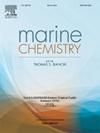Carbonate system and acidification of the Adriatic Sea
IF 3
3区 地球科学
Q2 CHEMISTRY, MULTIDISCIPLINARY
引用次数: 0
Abstract
Although the marginal seas represent only 7 % of the total area of the ocean, CO2 fluxes are important for the carbon budget, exposing them to the intense process of anthropogenic ocean acidification. The Adriatic Sea is currently a CO2 sink (−0.5 to −1 mol C m−2 y−1) with an annual flux comparable to the net sink rates in the NW Mediterranean. Based on a comparison of two winter cruises carried out in the 25-years interval between 1983 and 2008, an acidification rate of 0.003 pHT units y−1 was estimated in the northern Adriatic which is similar to the Mediterranean open waters (with recent estimations of −0.0028 ± 0.0003 pHT units y−1) and the surface coastal waters (−0.003 ± 0.001 and − 0.0044 ± 0.00006 pHT units y−1). The computed Revelle factor for the Adriatic Sea (approximately 10) indicates that the buffer capacity is rather high and that the waters do not appear to be particularly exposed to acidification. Total alkalinity (TA) in the Adriatic (2.6–2.7 mmol kg−1) is in the upper range of TA measured in the Mediterranean Sea. This is primarily due to the riverine inputs which transport carbonates dissolved from the Alpine dolomites and karstic watersheds. The Adriatic Sea is the second sub-basin (319 Gmol y−1), following the Aegean Sea (which receives the TA contribution from the Black Sea), that contribute to the riverine TA discharges into the Mediterranean Sea. About 60 % of the TA inflow into the Adriatic Sea is attributed to discharge from the Po River with a TA of ∼3 mmol kg−1 and TA decreases with increasing salinity. The north Adriatic dense water spreading and cascading is an efficient mechanism for exporting TA and DIC at depth, from the northern Adriatic towards the bottom of the South Adriatic Pit and possibly to the eastern Mediterranean. Saturation states indicate that the waters of the Adriatic are supersaturated throughout the year with respect to aragonite (ΩAr). However, the saturation state is considerably lower in the bottom water layers, due to the prevalence of the bottom layer and benthic remineralisation in the stratification period. Effects on calcifying organisms and phytoplankton are expected in the future.
亚得里亚海的碳酸盐系统与酸化
虽然边缘海只占海洋总面积的 7%,但二氧化碳通量对碳预算非常重要,使其受到人为海洋酸化过程的严重影响。亚得里亚海目前是一个二氧化碳汇(-0.5 至 -1 摩尔 C m-2 y-1),其年通量与地中海西北部的净汇率相当。根据对 1983 年至 2008 年 25 年间两次冬季巡航的比较,估计亚得里亚海北部的酸化率为 0.003 pHT 单位年-1,与地中海开阔水域(最近的估计值为-0.0028 ± 0.0003 pHT 单位年-1)和沿岸表层水域(-0.003 ± 0.001 和 - 0.0044 ± 0.00006 pHT 单位年-1)相似。计算得出的亚得里亚海雷维尔因子(约 10)表明,亚得里亚海的缓冲能力相当高,水体似乎并不特别容易酸化。亚得里亚海的总碱度(TA)(2.6-2.7 mmol kg-1)处于地中海测得的总碱度的上限范围。这主要是由于从阿尔卑斯白云岩和喀斯特流域溶解的碳酸盐被河流输入所致。亚得里亚海是继爱琴海(接收来自黑海的 TA 量)之后,第二个向地中海排放河流 TA 量的子流域(319 Gmol y-1)。流入亚得里亚海的 TA 大约有 60% 来自波河,其 TA 为 3 mmol kg-1 左右,TA 随盐度增加而减少。北亚得里亚海稠密水域的扩散和层叠是将 TA 和 DIC 从亚得里亚海北部向南亚得里亚海海坑底部并可能向地中海东部深度输出的有效机制。饱和状态表明,亚得里亚海水域的文石(ΩAr)全年都处于过饱和状态。不过,底层水的饱和状态要低得多,这是由于底层水和底栖生物在分层期的再矿化现象普遍存在。预计未来会对钙化生物和浮游植物产生影响。
本文章由计算机程序翻译,如有差异,请以英文原文为准。
求助全文
约1分钟内获得全文
求助全文
来源期刊

Marine Chemistry
化学-海洋学
CiteScore
6.00
自引率
3.30%
发文量
70
审稿时长
4.5 months
期刊介绍:
Marine Chemistry is an international medium for the publication of original studies and occasional reviews in the field of chemistry in the marine environment, with emphasis on the dynamic approach. The journal endeavours to cover all aspects, from chemical processes to theoretical and experimental work, and, by providing a central channel of communication, to speed the flow of information in this relatively new and rapidly expanding discipline.
 求助内容:
求助内容: 应助结果提醒方式:
应助结果提醒方式:


